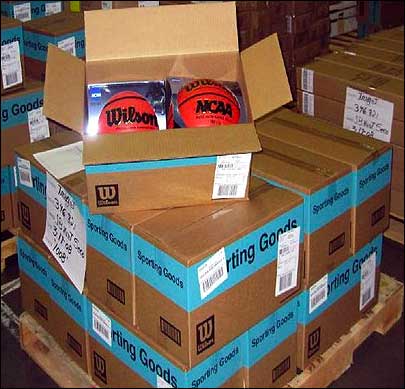As the former director of integrated systems for Pacific Cycle, one of the first consumer goods manufacturers to begin tagging product bound for RFID-enabled Wal-Mart distribution centers, Edwin Matthews knows his way around RFID (see Pacific Cycle Integrates RFID Data). That knowledge came in handy when he began working for Wilson Sporting Goods, which manufactures a range of sports products such as basketballs and baseball bats, to prepare that company to begin tagging products in compliance with Wal-Mart’s mandate as well.
Having met its January 2007 tagging deadline, Wilson Sporting Goods—owned by Amer Sports, a large sporting goods manufacturer that also owns Salomon, Atomic and Precor—is now ramping up to begin tagging additional products in order to leverage its investment in new RFID infrastructure. That infrastructure change involved the deployment of an enterprise resource planning (ERP) platform made by SAP.
When Wilson first started tagging select products, it had to manually divert orders containing the specific products that needed to be tagged. Now, it uses the Auto-ID Infrastructure software tool within the SAP ERP to automatically flag and divert any to-be-tagged products as they are received from the factory. This, he says, has made the process less labor- and time-intensive.
Between January 2007 and January 2008, Matthews estimates that Wilson consumed 200,000 tags by tagging a few stock-keeping units (SKUs) of baseball mitts, tennis rackets and basketballs headed for a handful of Wal-Mart DCs in Texas. The number of tags consumed, he says, should increase to 300,000 this year, and the number of SKUs Wilson will tag will also increase.
The products Wilson intends to begin tagging include baseball bats, but the aluminum construction of some bats interferes with RF signals, making the RFID tags attached to cases of bats difficult to read. “We are experimenting with using different packaging [for the bats],” Matthews states, “to add an air buffer behind the tag that will make the tag easier to read.”
Wilson brought in RFID system integrator Peak Technologies to work with Matthews and help the company develop and deploy its RFID tagging system. Wilson is now employing Zebra Technology R110Xi RFID printer-encoders to create RFID-enabled shipping labels for the cases and pallets. The R110Xi devices receive the order information necessary to produce the labels—the shipping address, order information and Electronic Product Code (EPC) to be encoded to each tag—through an XML interface to the SAP Auto ID Infrastructure (AII) software running at the Wilson distribution center.
Each label includes human-readable text, a bar code and an EPC number encoded on an Alien Technology EPC Gen 2 Squiggle inlay embedded inside the label. The labels are hand-applied to the cases and pallets, which are then routed past fixed-position Motorola RFID interrogators to capture the tag data as the shipments are being loaded onto trucks bound for Wal-Mart.
According to Matthews, RFID tag technology has significantly improved since his experiences deploying RFID at Pacific Cycle in 2004 and 2005. “This time around,” he says, “it is so much easier, in terms of [tag] readability.”
Matthews and his team are currently in the process of collecting and analyzing tag-read data from Retail Link, Wal-Mart’s supplier feedback service, and hope it will provide valuable insights into bottlenecks or other problems at Wal-Mart’s DCs and retail stores. He notes that one of the applications of RFID in which Wilson sees potential value is the tracking of promotional displays, because the company launches new products each year.
A number of product suppliers are deriving benefits from employing RFID to track promotional items and displays at retail stores (see P&G Finds RFID ‘Sweet Spot’, OATSystems Launches Solutions for Tracking In-Store Product Promotions and Maternity Apparel Maker to Deploy Smart Displays in Stores).


